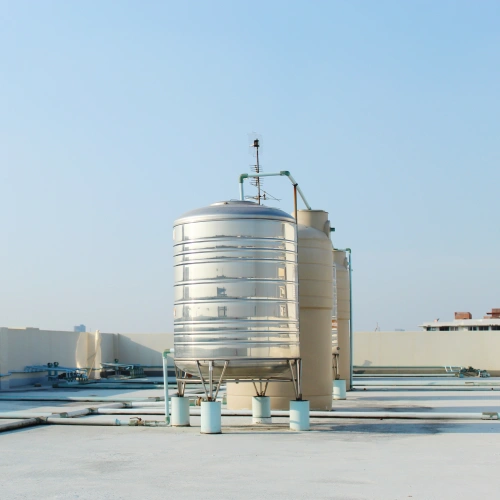Guide to Anti-Corrosion Treatment of Stainless Steel Water Tanks
Why Stainless Steel Water Tanks Corrode
Stainless steel is known for its corrosion resistance, primarily due to the protective oxide layer on its surface. However, certain conditions can compromise this layer, leading to corrosion. Here are some common reasons:
1 Environmental Factors
High Chloride Exposure: Water containing high levels of chlorides, such as seawater or industrial wastewater, can accelerate pitting and crevice corrosion.
Extreme Humidity: Prolonged exposure to high humidity can increase the likelihood of rust formation, especially if the protective layer is damaged.
Acidic or Alkaline Conditions: Extreme pH levels can deteriorate the stainless steel surface, making it more vulnerable to corrosion.
2 Types of Corrosion Affecting Stainless Steel Tanks
Pitting Corrosion: Small, localized holes form on the surface due to exposure to aggressive ions like chlorides.
Crevice Corrosion: Occurs in narrow spaces where stagnant water leads to oxygen depletion, causing localized corrosion.
Galvanic Corrosion: When stainless steel comes into contact with a different metal in the presence of an electrolyte, an electrochemical reaction can accelerate corrosion.
Understanding these factors is essential for implementing effective anti-corrosion treatments.
Common Anti-Corrosion Treatments for Stainless Steel Water Tanks
Several anti-corrosion methods can enhance the durability of stainless steel water tanks. These treatments focus on protecting the tank’s surface, preventing environmental damage, and ensuring long-term performance.
1 Surface Treatment Methods
Pickling and Passivation
Pickling involves removing contaminants, oxides, and scale from the stainless steel surface using a chemical solution, typically containing nitric or hydrofluoric acid. This process cleans the metal and prepares it for passivation.
Passivation follows pickling and enhances corrosion resistance by forming a uniform, protective oxide layer. Using nitric acid or citric acid, passivation removes free iron from the surface, reducing the risk of rust formation.
Electropolishing
Electropolishing is an electrochemical process that smooths and polishes the stainless steel surface, removing microscopic imperfections that can trap corrosive substances. This process enhances the metal’s resistance to corrosion while improving its aesthetic appeal.
2 Protective Coatings and Linings
Applying protective coatings and linings can create a physical barrier between the stainless steel and corrosive elements.
Epoxy Coatings: A durable, chemical-resistant coating that provides an extra layer of protection against moisture and aggressive chemicals.
Rubber Linings: Used in industrial applications to prevent direct contact between corrosive substances and the stainless steel surface.
Ceramic Coatings: Highly resistant to wear, abrasion, and corrosion, making them suitable for tanks exposed to harsh conditions.
3 Cathodic Protection
Cathodic protection reduces corrosion by altering the electrochemical environment of the stainless steel surface.
Sacrificial Anodes: Made of a more reactive metal, such as aluminum or zinc, these anodes corrode instead of the stainless steel, protecting the tank.
Impressed Current Cathodic Protection (ICCP): Uses an external power source to supply a continuous flow of electrons, preventing corrosion more effectively than sacrificial anodes.
4 Alloy Enhancement & Material Selection
Choosing the right stainless steel grade can significantly impact corrosion resistance.
304 Stainless Steel: Suitable for general water storage but less resistant to chloride-induced corrosion.
316 Stainless Steel: Contains molybdenum, offering better resistance to chlorides and acidic environments.
Duplex Stainless Steel (e.g., 2205): Provides superior strength and corrosion resistance, ideal for harsh industrial conditions.
Best Practices for Maintaining Corrosion Resistance
Even with proper anti-corrosion treatments, regular maintenance is crucial for extending the lifespan of stainless steel water tanks.
1 Regular Cleaning and Inspection
Remove sediments, algae, and biofilm buildup to prevent microbial-induced corrosion.
Inspect the tank’s interior and exterior for signs of rust, pitting, or coating damage.
Use mild detergents and avoid harsh chemicals that could damage the protective layer.
2 Proper Water Treatment
Monitor water pH levels to ensure they remain within a neutral range (6.5-8.5).
Install filtration systems to remove chlorine, sulfates, and other corrosive elements.
Use corrosion inhibitors if necessary, particularly in industrial applications.
3 Preventive Measures
Avoid contact with dissimilar metals to prevent galvanic corrosion.
Ensure proper ventilation to minimize condensation buildup inside the tank.
Regularly check and replace sacrificial anodes if using cathodic protection.
Corrosion is a significant concern for stainless steel water tanks, but with the right treatments and maintenance, their lifespan can be significantly extended. From surface treatments like pickling and passivation to protective coatings and cathodic protection, multiple methods are available to enhance durability. Regular cleaning, proper water treatment, and choosing high-quality materials further ensure long-term corrosion resistance.
Investing in a well-protected stainless steel water tank not only guarantees safe water storage but also minimizes maintenance costs and extends the tank’s service life. By following these guidelines, users can ensure their stainless steel tanks remain in excellent condition for years to come.

